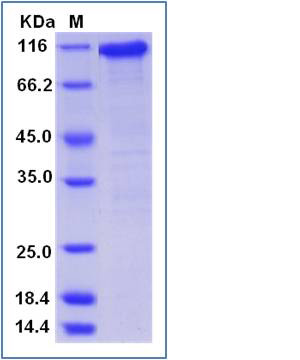Human beta-Catenin / CTNNB1 Protein (His & GST Tag)
armadillo,CTNNB,MRD19
- 100ug (NPP3605) Please inquiry
| Catalog Number | P11279-H20B |
|---|---|
| Organism Species | Human |
| Host | Baculovirus-Insect Cells |
| Synonyms | armadillo,CTNNB,MRD19 |
| Molecular Weight | The recombinant human CTNNB1/GST chimera consists of 1018 amino acids and has a calculated molecular mass of 113 kDa. It migrates as an approximately 116 kDa band in SDS-PAGE under reducing conditions. |
| predicted N | Met |
| SDS-PAGE |  |
| Purity | > 87 % as determined by SDS-PAGE |
| Protein Construction | A DNA sequence encoding the human CTNNB1 (P35222-1) (Met 1-Leu 781) was fused with the N-terminal polyhistidine-tagged GST tag at the N-terminus. |
| Bio-activity | Measured by its ability to bind biotinylated mouse ERBB2 in a functional ELISA. |
| Research Area | Epigenetics |Transcription |Transcription Factor & Regulator |Transcriptional Co-Activators |
| Formulation | Lyophilized from sterile 50mM Tris, 100mM NaCl, 2mM GSH, 10% gly, pH 8.0 1. Normally 5 % - 8 % trehalose and mannitol are added as protectants before lyophilization. Specific concentrations are included in the hardcopy of COA. |
| Background | beta-Catenin, also known as CTNNB1, is a member of the armadillo family of proteins. These proteins have multiple copies of the so-called armadillo repeat domain, which is specialized for protein-protein binding. It is part of a complex of proteins that constitute adherens junctions (AJs). AJs are necessary for the creation and maintenance of epithelial cell layers by regulating cell growth and adhesion between cells. CTNNB1 also anchors the actin cytoskeleton and may be responsible for transmitting the contact inhibition signal that causes cells to stop dividing once the epithelial sheet is complete. Finally, beta-Catenin binds to the product of the APC gene, which is mutated in adenomatous polyposis of the colon. Defects in beta-Catenin can cause colorectal cancer, pilomatrixoma (PTR), medulloblastoma, and ovarian cancer. CTNNB1 is a key dowstream component of the canonical Wnt signaling pathway. In the absence of Wnt, it forms a complex with AXIN1, AXIN2, APC, CSNK1A1 and GSK3B that promotes phosphorylation on N-terminal Ser and Thr residues and ubiquitination of CTNNB1 via BTRC and its subsequent degradation by the proteasome. In the presence of Wnt ligand, beta-Catenin is not ubiquitinated and accumulates in the nucleus, where it acts as a coactivator for transcription factors of the TCF/LEF family, leading to activate Wnt responsive genes. CTNNB1 is involved in the regulation of cell adhesion. The majority of beta-catenin is localized to the cell membrane and is part of E-cadherin/catenin adhesion complexes which are proposed to couple cadherins to the actin cytoskeleton. |
| Reference |
